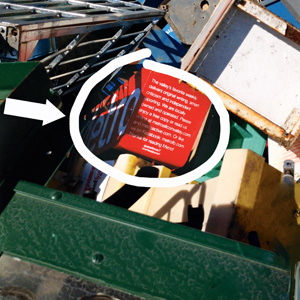A key piece of evidence has disappeared in the San Jose Mercury News rack theft caper.
Last week, San Jose police were called to the newspaper’s headquarters after an independent distribution firm discovered its news racks—along with those of more than a dozen other local publications—in a metal recycling dumpster behind the daily’s plant.
The recycling container, about the dimensions of a mid-sized moving van’s cargo area, was mostly full, and more news boxes were stacked around the dumpster. The operation to round up and destroy racks apparently targeted the distribution channels of competitors to San Ramon–based Bay Area News Group (BANG), which owns daily newspapers from Marin to Monterey, including the Mercury News, and community weeklies in Silicon Valley.
“We’d been losing at least three a week,” said Tom Lilledahl, of Mountain View–based Circulation Management Inc. After racks disappeared on Willow Glen’s Lincoln Avenue and The Alameda in San Jose, CMI personnel went to the Mercury News’ Ridder Park Drive plant and found its missing property, along with news boxes of Metro, the Palo Alto Daily Post, the Mountain View Voice, Good Times, La Oferta, the San Francisco Chronicle and other publications.
When shocked representatives of Metro, the Palo Alto Daily Post and CMI showed up at the Ridder Park Drive plant to reclaim their property, San Jose police officers and Mercury News security personnel ordered them to wait on the sidewalk. The Daily Post‘s publisher was reportedly threatened with arrest when he went to recover a rack.
The situation was defused after SJPD offered to take a report and document the evidence, and a Mercury News executive agreed to remove the racks from the dumpster, count and organize the racks and allow the publications to recover their property the next day.
The Merc did not keep the agreement, however.
On Thursday, it asked for more time to empty the dumpster and offered to deliver the seized racks rather than have publishers pick them up. On Friday, the Mercury News showed up with only four of the five Metro racks that it had in its possession.
Where’s Rack # 5?
At least one news rack in the Merc‘s possession vanished as the San Jose Police Department prepared to commence a criminal investigation into the daily’s dumping of its competitors’ racks.
Mercury News executives offered no explanation for the evidence tampering—only that they had “triple checked” the yard and can’t locate it. Without the missing box—a months-old, recently-redesigned Metro news rack—it will be harder to unravel the mystery and trace whether the Mercury‘s sweep of competitors’ stands was centered mainly in Palo Alto or if the media giant was also behind the recent disappearances of street distribution boxes in San Jose, which were reported by three organizations.{pagebreak}
Since the initial discovery, a series of contradictory and misleading statements released by the Mercury News and BANG has left many of the independent publishers—and even some public safety officials in Silicon Valley—incredulous. The media chain initially claimed it was “contacted by local authorities” in Palo Alto and “instructed to remove several news racks that were not in compliance with a local rack ordinance.” The statement went on to say that the removals of racks is “a normal practice in the industry” and the Merc notified individual publishers whose racks were removed.
But Palo Alto Weekly publisher Bill Johnson called the rack removals “every publisher’s worst nightmare” when he was notified by Metro the day following the Merc‘s statement.
“What!” exclaimed an incredulous Kevin Babeaux, owner of the Belmont-based Pink Spots LGBT publication, when informed Thursday of the confiscations. “That’s disgusting. That’s our property.”
A follow-up statement by David Rounds, vice president of circulation for BANG, said that the Merc received calls from the Palo Alto police dispatch to remove racks from two different locations in Palo Alto. Again, that claim was swiftly disputed.
“I can tell you that it’s not our policy and certainly not our standard procedure to be directing one company to remove news rack or anything like that,” said Palo Alto police Lt. Zach Perron. “That’s not even enforced by the police department. It’s done by the public works department.” He added, “I don’t know if such a call occurred, but it would surprise me if it did.”
With BANG owning almost every major daily newspaper in the Bay Area outside of San Francisco, some publishers and circulation managers have wondered if BANG has taken a systematic approach to further squash competition, aside from consolidation.
“What that says to me is that they’re completely disorganized, or else they’re really organized and it’s intentional,” says Lilledahl, who has had multiple run-ins with the Merc in the past.
In a March 2004 letter to Lilledahl from Harry Woldt, then VP of Circulation for the Mercury News, an agreement was made to dismiss a lawsuit filed by Lilledahl and CMI after two CMI racks went missing from a Coco’s Restaurant in Sunnyvale. In exchange, Woldt wrote, the Merc would “not remove any news racks or instruct any third party to remove any newsrack owned by CMI from public or private party without prior consent.”
The letter went on to say the Merc had “intended to return the news racks to CMI, but have been unable to locate the news racks as of this time.”
Mercury News officials offered no explanation for the disappearance of the fifth verified Metro rack under their watch, nor have they provided any accounting of the dates, locations and quantity of racks picked up in the past. In the last six months, more than 5 percent of Metro‘s newly designed news racks have disappeared from the streets.
After extensive coverage on television and radio newscasts, in the community press and on media industry websites, a new twist emerged when BANG publications covered the story in its low-circulation Saturday edition’s business sections. In the article, the Mercury News suggested that the recycling of competitors’ racks was a “mistake” by a single employee, and the count shrank from earlier reports.
Bob Lampkin, a circulation director of Embarcadero Media, was quoted in the article describing the news rack removals as “a totally normal situation.” It was also noted that Lampkin previously worked for the Mercury News.
BANG vice president of circulation David Rounds told his paper that “the racks the Mercury News removed were left along a fence behind the newspaper’s headquarters for pickup. However, while 17 racks were lined up by the fence, an employee mistakenly tossed seven others into a recycling bin.”
The article did not explain why the employee selected nearly-new boxes of the Daily Post and Metro for recycling while he elected not to toss a collection of rusty old racks nearby.
On Monday, Rounds maintained that the Metro rack that had been photographed on Wednesday at the bottom of the metal heap was nowhere to be found. He added in a separate email that BANG had “engaged an outside firm to conduct a thorough investigation” of the rack removals.
“If I had your news rack,” he told Metro, “I’d give it back.”

 Restaurants: Sawa in Sunnyvale
Restaurants: Sawa in Sunnyvale  Good Karma Bikes Helps Set a Path to Recovery
Good Karma Bikes Helps Set a Path to Recovery 






